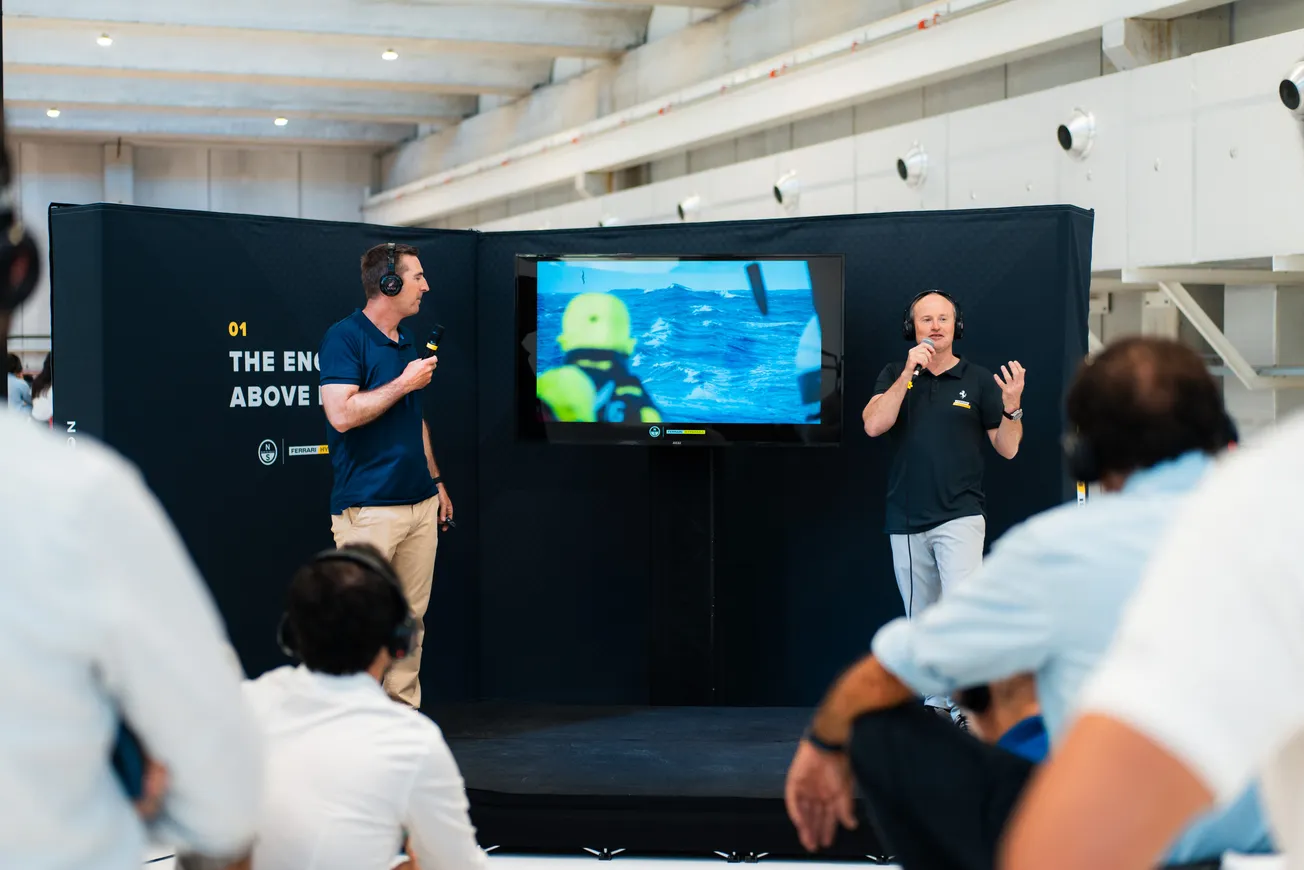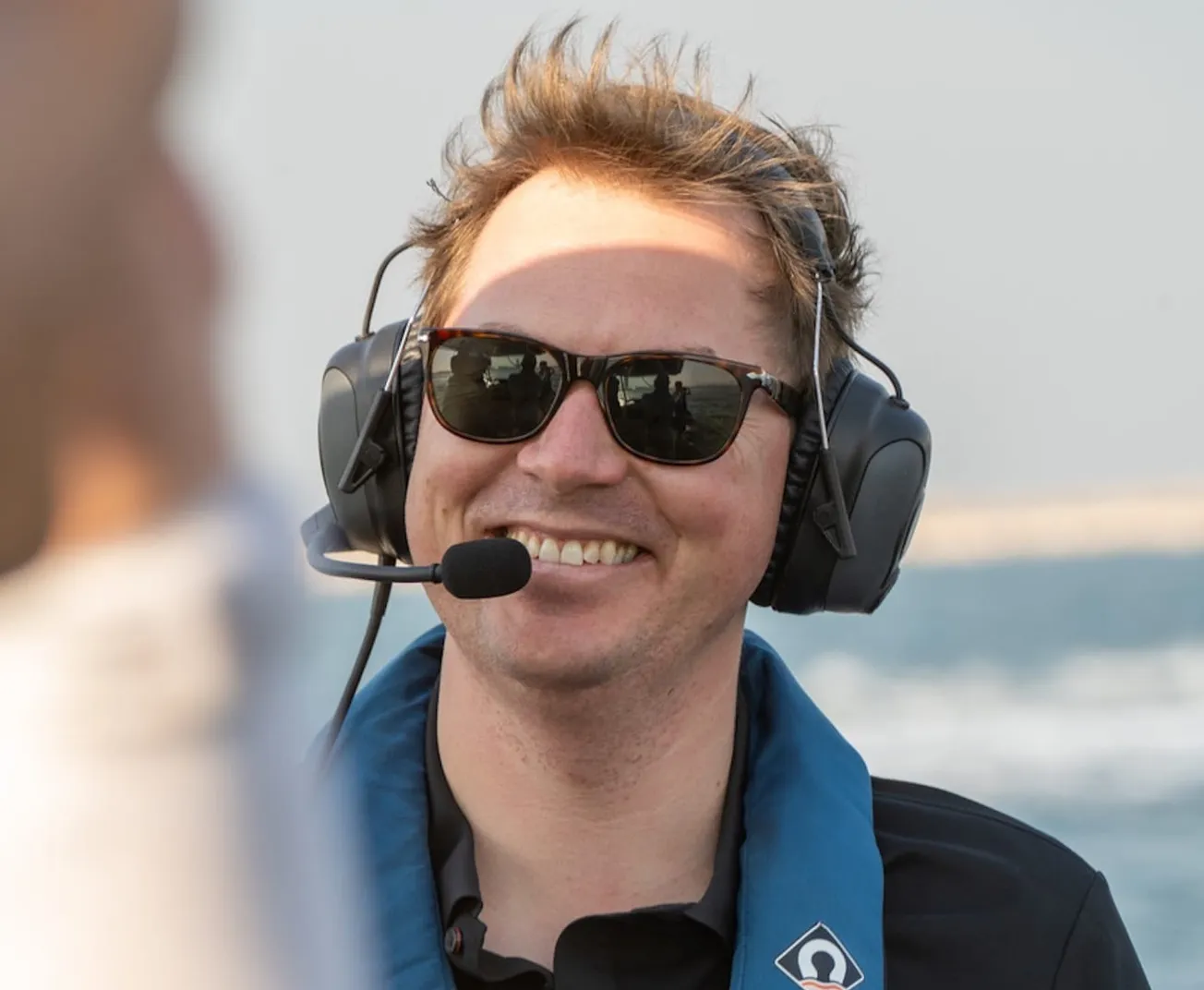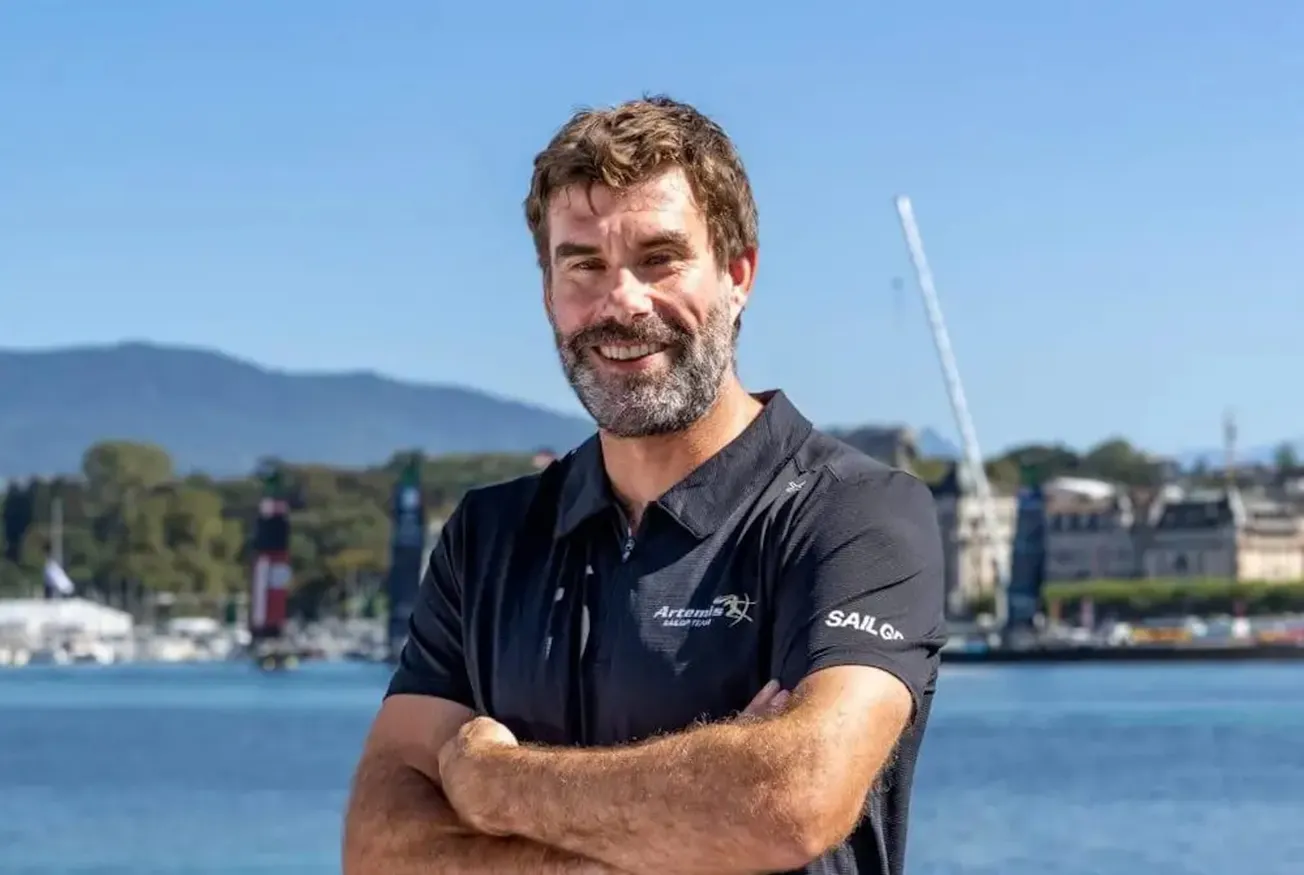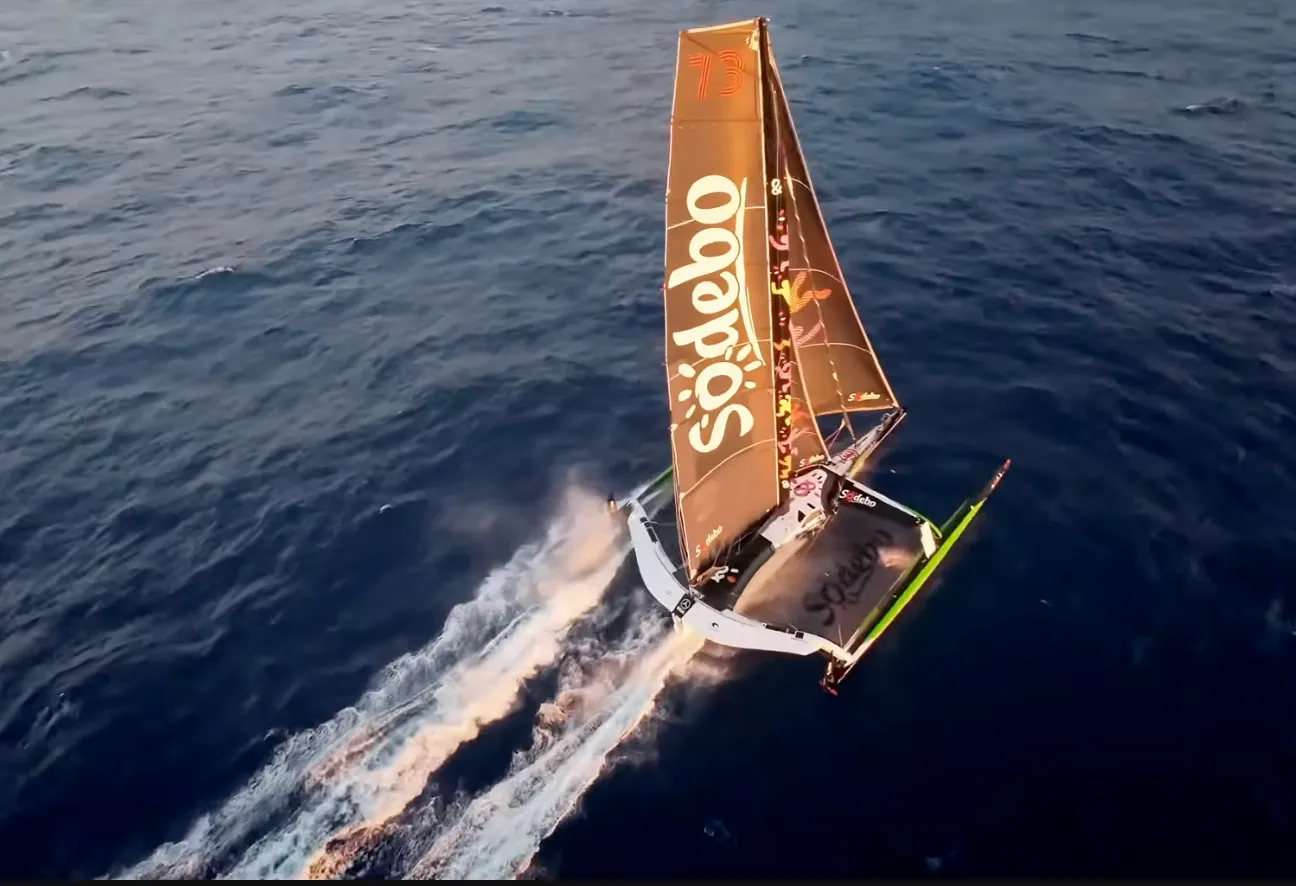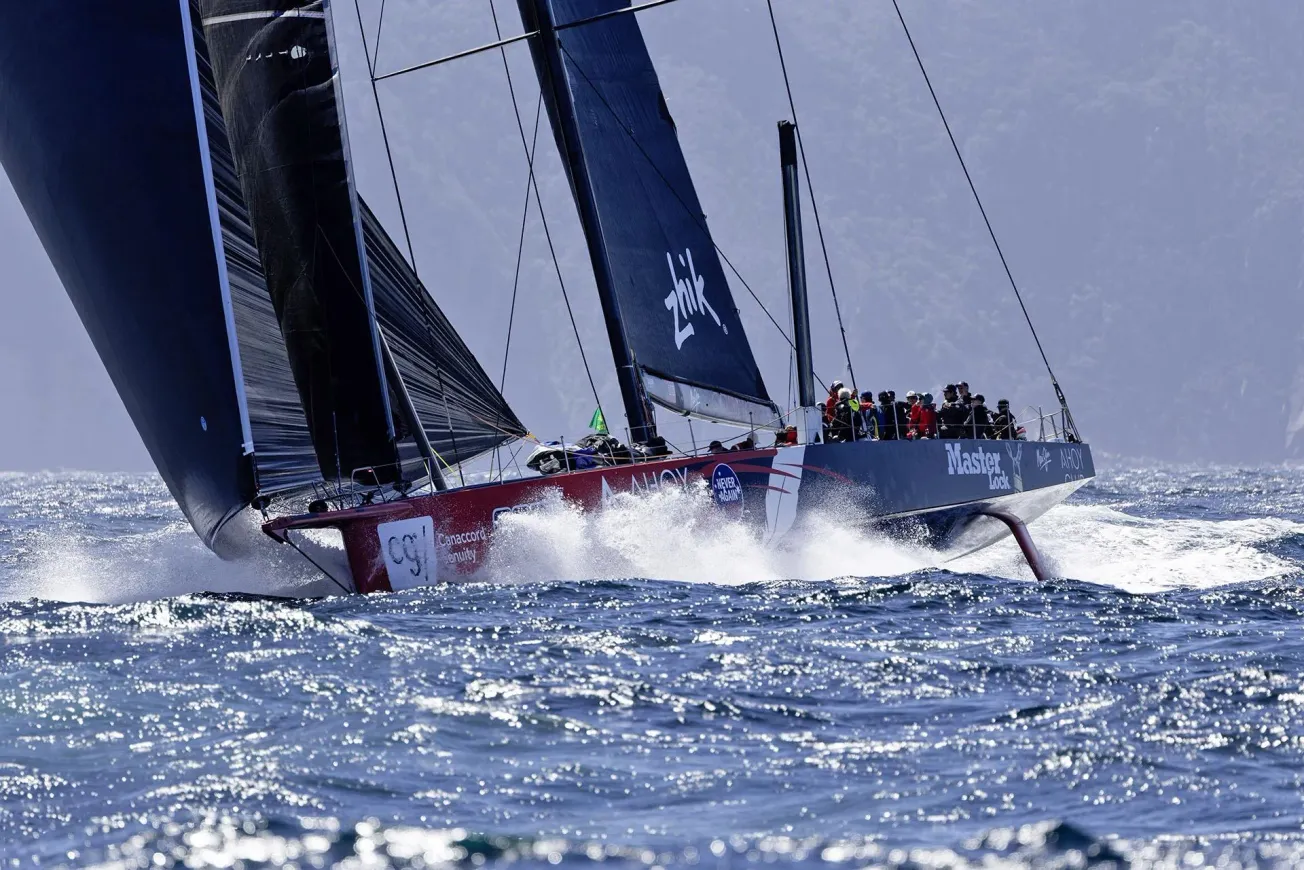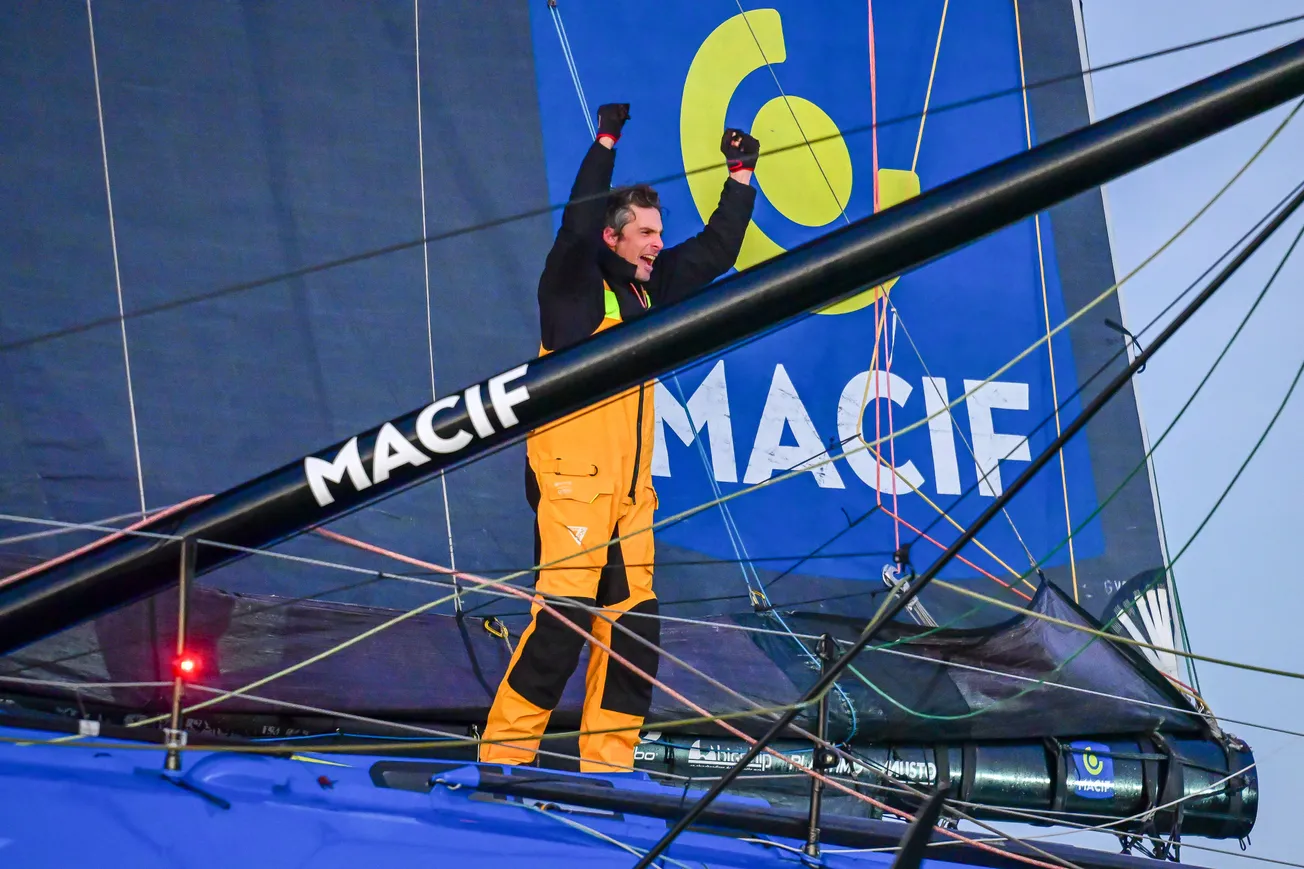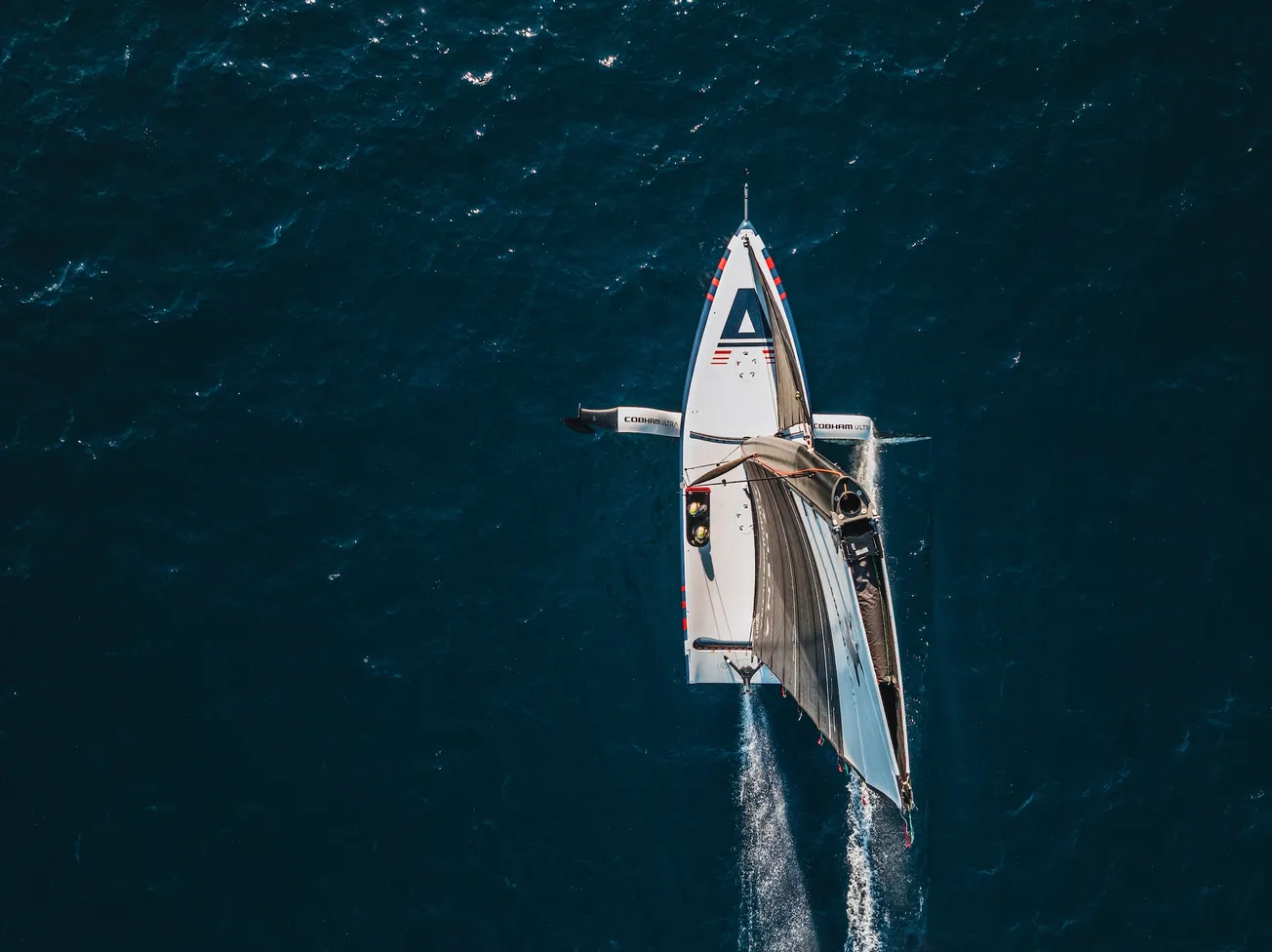

Powered by RedCircle
Justin Chisholm
Tell me how you got involved in this. What was the approach? You were sitting at home and the phone rang? What happened?
Glenn Ashby
It was quite funny. I was actually with Southern Spars in Monaco, doing the breakfast talk for them after the land speed project with Team New Zealand and Guillaume [Verdier, Hypersail designer] turned up with Marco [Guglielmo Ribigini, Hypersail project lead at Ferrari], with Matteo [Lanzavecchia, the Chief Technology Officer (CTO) for the Ferrari Hypersail project who also leads Ferrari’s sports car engineering division] and a few of the guys, and basically said, Glen, we need to have a chat.
So basically Guillaume said “Look, we're doing this project. We can't tell you a whole lot about it, but we think you're the perfect guy to be involved with this. It's sort of quite unique and quite different, pushing boundaries, and probably something that you'd really enjoy with the background that you've had, coming from developmental sailing with the A Class and C Class (catamarans) and all the America's Cup stuff and the Olympics and different bits and pieces.
So I had a follow up meeting a week or so later online with Marco and the Ferrari guys and they put a little bit of an idea on my mind, which I had a little bit of a think about. I was like: Wow. This is pretty cool. It's really different from the America's Cup side of things. I had just retired from my America's Cup career in 2021. Fast forward 18 months and then this is almost like the early days of the Oracle trimaran, the AC 72 and AC 50 and then into the AC75. The last four America's Cups that I've been involved with were largely developmental America's Cups. Now it's a bit more of a refinement [game] which is obviously super cool as well. But I've always loved pushing the technology and the boundaries and once I got to learn about what this project was actually about and how ambitious it all was, I was like, shit, this is actually something that I could be really interested in here.
Justin Chisholm
Did you have to think about it? Was there a moment where you thought “Are these guys for real?”
Glenn Ashby
Absolutely. I definitely needed to get some more information. So I'm just like, What are you trying to do here? Because this is pretty ambitious. And then once I did my homework a bit more and asked more questions and actually spoke to Guillaume properly. He is someone I have worked with for a long time and once he explained what the idea of the boat was and what they were trying to do with it, I was like: “Wow. That's pretty full on.
I've done a little bit of offshore sailing, but not a huge amount at all compared to Giovanni and a lot of other people. But I've obviously done a lot of development sailing over the years. So my role basically was to come in and actually help provide some of that sort of developmental knowledge [gained] after sailing a whole lot of different boats, and trying to help create what a boat could be to actually go out and sail offshore.
Time will tell whether I've actually had any influence on that or not, but it certainly is a wonderful experience and I guess it's a bit of a culmination of all the knowledge and all the years of sailing that I have done into this one big boat – so it's exciting.
Justin Chisholm
Where do you think the idea came from? Was it Giovanni? Was it Guillaume? Was it Ferrari?
Glenn Ashby
That’s a great question. And I don't know how much I can actually say on that, but what I will say is I think John Elkann [chairman of Ferrari] has known Guillaume and Giovanni for a long time. And I think it came about as a bit of a conversation. I think it might have been a wedding or a party or something like that. I can't remember where it was exactly. Don't quote me on that one, but they basically had to get together and I think Guillaume said as he does: “Oh yes I think we could do something along these lines, if you're interested”. That's where I think the seed got planted and then the rest sort of just evolved from there.
Ferrari, coming from the car industry, are stepping into a new world. But their ambitiousness, their technology, the push for the future, it fits perfectly with what they love doing: pushing technology, pushing the limits and being bold and brave. That, I think, is exactly what this project's all about. It's about pushing the boundaries,
Justin Chisholm
And your role – just so I understand who you're working for – you're wearing a Ferrari Hypersail t-shirt…
Glenn Ashby
I'm actually definitely working for Ferrari. Obviously I have a huge connection with North Sails and Southern Spars from the America's Cup and other previous projects. So the relationship that I have – with all the players that are involved – a lot of those relationships have been established over a long time. So my role – along with Giovanni – coming from the sailing side of things, is to work with all the departments – as well as Ferrari – in actually putting the project together – and hopefully not leaving any stone unturned. I guess my role, really, is to work with the Ferrari guys to help them with their dream of creating this boat.
It’s almost like a bit of a dream-come-true sort of a project [for me]. Like if you were a kid and someone said: “You're gonna go and work in Maranello in the Ferrari factory with a whole lot of Ferraris driving around and you're going to be working on a sailing project” you'd have to pinch yourself. As a 12 year old when I had a Ferrari Testarossa poster on my main bedroom wall. It's like a dream.
After getting towards the end of my America's Cup racing career and stepping away I've definitely evolved more into the sort of the technological design side of things. I feel like I've got a really good sort of understanding of how and why things work now, over the years, and now to be able to use some of that knowledge and that technical expertise in this project… I guess they saw me as someone that's come from a background of having to build things and push the limits – from a young kid all the way through to where I am now, at 48 years of age.
Justin Chisholm
Your focus is on the rig or are you across the whole project?
Glenn Ashby
My main focus is on the rig and the sails. Having said that, though, I'm actually heavily involved with pretty much everything else on the boat as well. I'm not an expert, by any means, in any one field. I never pretend to be. What I do feel I have is a good understanding of working well with all the different departments. Having a global understanding of what the boat is and what each department has to do. Getting the best out of the group of people that are there – promoting them to really lift up and step up and to not be afraid, to be bold and be brave. That's really my role within the team: being part of that group going forward that's actually pushing the boat to the limits that it needs to be [pushed to] to actually be successful.
Justin Chisholm
So it must feel a bit like an America's Cup team. But there are no rules to this and you've got a blank sheet of paper to start from. Does that make it harder for you? Is it easier to have a set of rules that you know you've got to conform to?
Glenn Ashby
It's a bloody good question. I think in some ways it's easier and in some ways it's harder. I think it's easier in some ways because you can look outside the square. You can take the blinkers off and say “What if we could do this?” – which we can't do on the America's Cup or we can't do in other classes, because we are bound by the rules. With this project you can have a bit more flexibility. So in that sense, it's amazing. You can really push into areas that you can't normally do.
There are obviously [some] rules that we need to abide by, but there is a lot more freedom. So for me, the personal joy of being able to look far afield, to look into the distance of where you could possibly go is amazing. With the America's Cup, it's now much more of a refinement game than it's ever been before, with the AC75 for example. So whilst I love all that and the fine details and – like you do in Olympic sailing – finding the little gains here and there, this is really like a quantum leap forwards in gains when you are developing. With this project, it's just incredible the games you can make really quickly – if you make the right decisions.
Justin Chisholm
What's the timeline been and what's the timeline going forward?
Glenn Ashby
I've been with the project now for about almost exactly two years. The guys were sort of working a few months before that. The boat will go on the water later next year and there's a really good detailed five-year plan of how that boat will be worked up and then eventually go and do some races around the world.
It’s not something you can just put in the water and turn the key and expect it to be perfect on day one. There's no one that's got those expectations. It's definitely a work up process that will happen over a few months. The commissioning will happen over a few months. There's a lot of new technology, new systems that have never been tested in real life.
[There’s been] a lot of bench testing and a lot of testing in the environments that you need. Ferrari do a lot of car testing so they're very well attuned to putting things through their paces before they go into real use. So we're using a lot of that technology in the production of the boat. So we're very confident that there will be minimal disruptions – even though there’s a new rig, new foils, a whole lot of new structure that's being pushed as well.
So we'll work the boat up over a period of time and then once we are comfortable that we can push everything hard, like you do with an AC75 for example, you can then go and race and be comfortable with it.
Justin Chisholm
Twin-skin mainsail I see. You've got the same challenge of having to have loads of camber and then have a flat sail as soon as the boat's up and foiling. It's an obvious choice. Were there other things considered?
Glenn Ashby
We did quite a decent study of sort of different options with that. And there will be some developments as we go forward. I sort of feel sort of pretty responsible for guiding the group into this twin-skin mainsail program – after being involved with the development of that with the America's Cup side of things. So I know very well how those rigs work and the advantages of the twin skin mainsail.
After we did some sail testing in Sardinia a year or so ago, I just said to the guys: “Look, this is all well and good. Would we ever consider taking this on – the twin-skin mainsail package? We did some numbers and showed the guys the advantages. Obviously, it's more difficult because we're in an offshore environment. You've got to get it up and down and reef it and that sort of thing. But we worked through it – North Sails and Southern Spars – all the guys together. We had lots of meetings and it became quite clear after doing the numbers on it just how much better performance we were going to get out of that rig.
So time will tell – I feel very responsible – and we definitely need to make sure it works. But I think it's a bit of a no brainer for this project. We can't be stopping and starting and reefing and shaking reefs out like existing boats have done in the past. We want something that we can just literally get through a huge range [of wind conditions] without actually having to take the throttle off while we're doing it.
Justin Chisholm
So the goal is to have the capability to reef if you need to not, but not have that as the first choice, correct?
Glenn Ashby
Yeah. The beauty of the twin-skin mainsail is that you can just get it through such a huge range of apparent wind speeds – and true wind speeds in actual fact as well. You see how fast the AC 75 rigs can go upwind and the amount of apparent going over the deck. I've experienced that for a long time. They [twin-skin mainsails] sit so beautifully stably by being able to separate the high and low pressure sides, which you can't do on a single skin because they flap and they twist and it upsets the boat. So, for me, it was a bit of a no-brainer to go to this. There will obviously be other future developments with the front sails and things like that – which we'll get to. This is a massively ambitious idea to take on, but with Southerns and North I know that it will be executed really well and we will be in great shape.
Justin Chisholm
Even with the AC 72 [in San Francisco back in 2013] we saw the end of the idea of spinnakers, of code zeros and all that sort of thing. I've seen some of the computer generations here with conventional-looking headsails. Is that a reality, or will it just be a bladed jib?
Glenn Ashby
[Smiling] You've got to have something to start with at a render at a launch, don't you? As I have said before, there's definitely some configurability with the boat. We will have some furling headsails on the boat, as well as the options for doing other things. The beauty about the boat is that we will be able to chop and change. And actually it's a development boat. It's not a case of ‘we're going to start with this and we're going to finish with this. It will keep developing. There's a full development plan going on behind the scenes at the moment, which I'm absolutely loving. Being able to sort of go: “Wow, could we do this? Could we do that? And having the support of Southern Spars, North Sails, and all the Ferrari guys all working together, it feels like nothing's impossible at the moment. We've just got to work our way through it.
So we will keep developing on that front sail side. Whilst we can put big sails up the front if we need to – if we're sailing in light air conditions – the aim of the boat's not to be sailing around in five knots everywhere.
Justin Chisholm
The boat is in construction, but it's built somewhere in a computer model. You've seen it, and you've seen the data. What does it compare to? I'm obviously thinking of the Ultims. Can it outperform the Ultims, do you think?
Glenn Ashby
I can't really tell you the exact number at the moment. But certainly in the sort of moderate to windier conditions – which the Ultims are targeting as well (you're not going to go and try and set a Jules Verne record if you're targeting five or 10 knots of wind) – I think reaching and upwind and possibly downwind as well this boat's got all the potential of being quicker than any of the big multihulls.
Justin Chisholm
With the twin-skin mainsail is it just a case of scaling everything up [from an AC75]? Or do you have to change the materials, the design of the mast, etc.?
Glenn Ashby
This boat is much, much heavier – to deal with what we're going to put it through – than the America's Cup boats are. It is a big scaling up in some ways, but the way the mast operates and the way the sails operate are quite a bit different to what we use on the America's Cup. With all that all the knowledge that we've gained in the past of the America's Cup, this rig has almost been spat out the back of all that development, if you like.
So it actually is super highly advanced, not only in the way it bends and the range that you can get it through, but also in the technology and the construction of the actual mast itself – and the sails. There's been a lot of learnings over the America's Cup, over the last five to eight years of the AC75 sort of design phase. This really is a by-product, or a spit out at the end of all that knowledge. It’s going to be really the latest and greatest rig that's probably ever been produced, let alone being an offshore rig.
Justin Chisholm
New materials?
Glenn Ashby
There will definitely be some new materials in there – as well as a lot of existing materials, which we have a lot of knowledge about. But one thing Ferrari are extremely good at is pioneering and pushing new material technology. So they have a massive amount of knowledge coming about that, coming from Formula One and the supercar side of things. So they are very, very good at learning very quickly what new materials can be put into different solutions. Right the way throughout the boat they're using their technology to actually feed into it. So that's pretty amazing from my perspective,
Justin Chisholm
Offshore foils. Are we going to be surprised by what we see in terms of shapes?
Glenn Ashby
I don't think we'll be surprised really too much. Obviously we have a canting keel and we have foil flaps on the keel bulb itself. We have two foil arms with a huge span. So whilst there will be different configurations, the actual foil look won’t be super surprising for people in the know. However, have we ever seen an offshore boat that’s capable of being pushed in big waves that's been fully foiling? That's never been done before, so it's pretty exciting.
Justin Chisholm
There's a huge amount of risk to all of this. I think some of that is offset by a company like Ferrari being involved. They know about risk. They're in a risky motor sport. For you personally, do you feel that there’s a risk that: “What if it doesn't work?”
Glenn Ashby
Absolutely. Risk management has been something I have been involved with for a long time from a sailing perspective. How hard can you push the boat? When you're sailing your A Class or your Moth or your Tornado or your Extreme 40, or whatever it is, the AC75 maybe – you know you need to learn where the edge is from a sailing perspective. Then you need to step back and learn where the edge is from a construction and engineering and development perspective. That rounded approach, I feel like I have a much better knowledge of now, after being spat out the back of my career and having seen the good, the bad and the ugly over the years.
It absolutely is risky. It is scary, highly ambitious, but extremely exciting and innovative as well. So it's just that risk management side of things which I think drives everybody. And when you've got companies like Southern Spars, North Sails, and Ferrari all coming together, that risk management side of things is very much under control.


